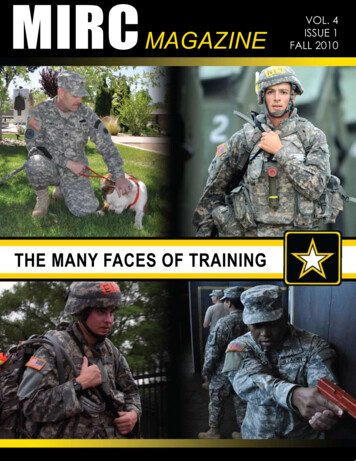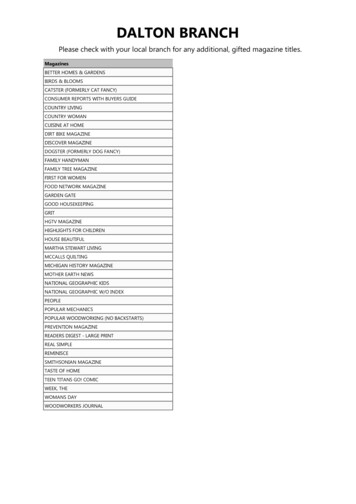
Transcription
MIRC MAGAZINETHE MANY FACES OF TRAININTHE MANY FACES OF TRAININGVOL. 4ISSUE 1FALL 2010
2MIRC Magazine Vol. 4, Issue 1 Fall 2010
ContentsFrom the Commanding GeneralThe MIRC MuralFrom the Command Inspector General203rd & 321st Yellow RibbonContinuing to ServeMIRC FRA ProgramThe MIRC Celebrates Women’sHistory Month2400th MIG at Annual TrainingSoldier by Day, Derby Girl by NightTRICARE SMART WebsiteMIRC Career Management OfficeOperation Tribute to Freedom StorySgt. Delgado-MellaSoldier SpotlightMIRC Soldier Awarded OVSMBattlemindVOFORGEN325th Military Batallion WelcomesUFC FightersMIRC Best Warriors Coverage468101214MIRC COMMAND TEAMBrig. Gen. James V. Young, Jr.Commanding GeneralMs. Loretta S. CoxCommand Executive officerChief Warrant Officer 5 Denise ScarboroCommand Chief WarrantCommand Sgt. Maj. James J. Murrin15Command Sergeant Major of the MIRC16MIRC MAGAZINE STAFF1820Maj. Annmarie B. DanekerEditor in Chief, MIRC Magazine20Staff Sgt. Stephanie P. AbdullahContributing Editor2122Master Sgt. Jodi Gaston24 Graphic Designer25Spc. Erika MontanoPhotojournalist262728Crystal AdvertisingDesign ServicesSUBMISSIONS The MIRC Magazine invites articles, story ideas, photographs and other material of interest to members of the MIRC.Manuscripts and other correspondence for the editor should be addressed to MIRC, Attn: Public Affairs, 8831 John J. Kingman Road, Fort Belvoir,VA 22060, telephone 703-806-6126. All e-mail submissions should go to mirc news@usar.army.mil. All articles must be submitted electronicallyor on disk or CD. Unsolicited manuscripts and photographs will not be returned. Query by letter.CHANGE OF ADDRESS Do not write the magazine. TPU soldiers should notify their Unit Administrator or Unit Clerk. Members of the IRR andIMA should contact their Personnel Management Team at HRC-STL, 1 Reserve Way, St. Louis, MO 63132-5200.SUBSCRIPTIONS The MIRC Magazine is distributed free of charge to members of the Military Intelligence Readiness Command. Circulation isapproximately 6000. The MIRC Magazine is an authorized Department of the Army publication, published quarterly by the MIRC Public AffairsOffice. Opinions expressed herein do not necessarily reflect those of the Department of the Army or the Chief, Army Reserve, nor should they beconstrued as official policy or directive in nature. Local reproduction of all material is approved, except for copyrighted articles or photos.ON THE COVER Top left to right: Staff Sgt. Michael Chamberlain serves the nation by training service dogs to assist Wounded Warriors,photo by Spc. Erika Montano. Sgt. Daniel Acree participates in the 2010 Best Warrior Competition, photo by Timothy Hale. Bottom left to right:Spc. Aaron Thomas participates in the 2010 Best Warrior Competition, photo by Sgt. Joshua Risner. Sgt.1st Class George Conway, 2400th MilitaryIntelligence Group (MIG), leads his team in room clearing procedures during the unit’s annual training in San Diego, Calif., photo byMaj. Sharon Filadelfia.MIRC Magazine Vol. 4, Issue 1 Fall 20103
From the Commanding GeneralAs we head into the 2010 holiday season and the end of thecalendar year, I want to take this opportunity to wish all theSoldiers, Families, and friends of the Military Intelligence ReadinessCommand a joyous and peaceful holiday season.to find opportunities for active duty assignments to develop theirtechnical and leadership skill sets inside INSCOM formations.This initiative has received rave reviews from those who haveparticipated.With the ongoing battle against terrorism, many MIRC Soldierswill be away from their Families and friends over Thanksgiving,Christmas, Hanukkah and New Year’s. Separation from Family andloved ones is tough on those deployed and those at home, especially over the holidays. Many of you have already experiencedsuch separations and many more of youwill experience this type of separationin the future. Please take a moment toremember all these members of the MIRCFamily in your thoughts and prayers.I believe in these and other programs as a successful and productivemeans of training and mentoring our future leaders of the ArmyReserve and the Military Intelligence Corps. I encourage all Soldiersto seek out the assistance and opportunities provided as you startand then move up through your MI careers.In the midst of celebration and goodcheer, remember that the holidaysshould also be a time of safety. I askyou to use good judgment to plan yourtrips and evenings out wisely. Take intoconsideration traffic, weather, andalcohol consumption. Don’t be astatistic. I want all MIRC Soldiers tobe standing in morning formation atJanuary Battle Assembly.Our missions will continue into 2011.The MIRC currently has multiple unitseither deployed or getting ready todeploy. Detachment 25, 203rd MI Battalion, Weapons Intelligence Company,has Weapons Intelligence Investigatorsspread out across 15 Forward Operating Bases in Iraq, embedded withExplosive Ordinance Detachment (EOD)Teams and working in very austereremote locations, hand in hand withIraqi Security Forces. After a long,successful mission, the detachmentis getting ready to return home. The325th MI Battalion is also in Iraqand contributing to the intelligencemission and transition every day.The MIRC has accomplished many thingsin 2010. In the December 2009 issue ofthis magazine I mentioned many objecDetachment 26, 203rd MI Battalion,tives and goals for 2010. One was theand the 373rd MI Battalion (BfSB) areBrig. Gen. James “Boe” Young Commanding GeneralTPU Officer Career Management program.movingquickly through pre-mobilizaof The Military Intelligence Readiness CommandNow called the Career Management Officetion training and SRP, ramping up(CMO), the CMO team has provided guidance in professional devel- for movement into theater. Alpha Company, 345th MI Battalionopment, assisting over 100 officers in finding the right position inis currently at their mobilization station, training every day tounits, transferring branches, and preparing board files. The teamget ready for their rotation into theater. I have confidenceis ready to step in and assist MI officers who aren’t familiar withthat these three trained and ready units will succeed in all ofpolicies and procedures and will be visiting units to explain thetheir missions.concept more fully. Right now this program is geared toward TPUofficers but we are working hard to expand assistance to the NCOThe MIRC is still expanding our community outreach and strategicCorps. The CMO is here for you contact the team to seecommunications programs. The Public Affairs Office is pushing tohow they can help.tell our Soldiers’ stories through Facebook, Twitter, and thismagazine. We also want to continue to reach out to the localWe also have built upon VOFORGEN or “Volunteer Force Generacommunities around our units and tell them about the trainingtion” in our quest to match up qualified, trained professionalsand hard work that we accomplish. The PAO needs your ideas,with critical deployment missions. In the past year, 30 Soldiersphotos and stories in order to do that. All of the MIRC unitshave volunteered and have served in MI and non-MI missions inhave a Unit Public Affairs Representative; contact them aboutsupport of both Operations Enduring Freedom and Iraqi Freedom.submitting your stories and photos.The OPORD that explains VOFORGEN has been sent to the fieldand is also posted on the MIRC website on AKO.As we end one calendar year and begin another I am proud of allthat we have accomplished in 12 short months. The New Year willLeaders within the MIRC are working closely with our partner inbring us more challenges, more experiences, more missions. I amthe intelligence community, Intelligence and Security Commandconfident that we can be successful in accomplishing all that is(INSCOM), to ensure that junior officers and enlisted personnelasked of us, plus so much more!receive the training and experience necessary to become stronger,more effective Intelligence personnel and leaders. The JuniorHappy Holidays.Officer Development Program (JOPD) and the Junior EnlistedDevelopment Program (JEPD) are avenues that Soldiers can use44MIRC Magazine Vol. 4, Issue 1 Fall 2010
FROM THE COMMANDING GENERALDETERDETECTDEFENDDeter identitythieves bysafeguardingyour information.Detect suspiciousactivity by routinelymonitoring yourfinancial accountsand billing statements.Defend againstID theft as soonas you suspect it.MIRC Magazine Vol. 4, Issue 1 Fall 20105
Honoring OurStory and photo by Staff Sgt. Stephanie Abdullah, Military Intelligence Readiness Command Public Affairs OfficeThe Military Intelligence Readiness Command (MIRC) dedicated the MIRC Wall of Heroes mural at the MosbyArmy Reserve Center at Fort Belvoir, Va., to honor the six MIRC Soldiers who made the ultimate sacrifice whilein combat. Efforts to design, paint and frame the mural began in May 2009 and was officially unveiled oneyear later.The design of the mural was a coordinated effort among seven MIRC Soldiers: 1st Sgt. Angel Ortiz, theHeadquarters Headquarters Company (HHC) 1st Sgt.; Master Sgt. Sonja L. Bates, Provost Marshal; Master Sgt.David P. Landgrover, 1st Sgt.; Sgt. 1st Class Ronald C. Newton, HHC Training NCO; Sgt. 1st Class Tricia A. Morales,66MIRC Magazine Vol. 4, Issue 1 Fall 2010
HONORING OUR FALLEN HEROESFallen HeroesSoldiers with the MIRCstand in front of the Wallof Heroes mural at theMosby Army ReserveCenter, Ft. Belvoir, Va.,in honor of those whohave given the ultimatesacrifice. From left toright: Brig. Gen. LesliePurser, Warrant OfficerFloyd Bingham, Staff Sgt.Tricia Morales, Sgt. 1stClass Ronald Newton,Sgt. 1st Class SandraHawkins, Sgt. 1st ClassLydia Ruff, and Staff Sgt.Jeovanie Claudio.Theater Support Command Human Resources NCO; Staff Sgt. Jeovanie Claudio, G-8 Finance NCO; and Sgt.Hoori Khandani.Once the design was established, a team from the MIRC worked hard to paint the mural: Brig. Gen. LeslieA. Purser, former MIRC Commanding General; 1st Sgt. Angel Ortiz; Sgt. 1st Class Ronald C. Newton; Sgt.1st Class Tricia A. Morales; Sgt. 1st Class Lydia A. Ruff, G1 HR NCO; and Staff Sgt. Jeovanie Claudio.Warrant Officer Floyd C. Bingham, G-3 Mobilization Officer, completed the framework for the mural.MIRC Magazine Vol. 4, Issue 1 Fall 201077
By Lt. Col. Daniel G. Foulkrod, Military Intelligence Readiness Command Inspector at are the roles of the Inspector General (IG)? Many only see the IG as an investigator and assistor,but the IGs perform other roles that enable them to accomplish their primary mission: enhance thewarfighting and readiness capabilities of the command. This mission was developed by the earliestInspector General of the Army, Baron Von Steuben of Revolutionary War fame. He was brought into teach and train the continental Army drill and ceremony. This improved the readiness of the Army,increased its warfighting abilities, and enabled the Army to be more effective in fighting the British.Although IGs no longer are responsible for conducting drill and ceremony, they remain an extensionof the commander’s eyes, ears, voice and conscience. As the IG for Military Intelligence ReadinessCommand (MIRC), we serve the command, its Soldiers, civilians and Family members by workingto identify issues and provide analysis that result in solutions the commanding general (CG) canimplement.The IG is more than just an investigator and assistor. We have two other functions: teach andtrain Soldiers and commanders; and conduct inspections. Althoughmany don’t see the IG as the teachers and trainers, it is ourprimary function. As teachers and trainers,it’s our responsibilityto inform everyone:commanders, Soldiers,civilians and Family members.We help them understandlaws, regulations and policies,to include their underlyingreasoning. Teaching andtraining can be a standalonefunction or embedded in ourother functions. As a separatefunction, we can teach classes,provide guidance or disseminateinformation keeping everyoneupdated on recent changes.As an embedded function in ourother tasks, teaching and trainingrequires us to take the time to ensurethat commanders, Soldiers, civilians,and family members are aware oftheir responsibilities. While assisting aSoldier or conducting an investigationor inspection, we will explain processesand teach current doctrine to ensure allinvolved are aware of the rules.Sometimes this may mean the complainant will be advised that the unit has followed theregulation, law or policy. In these instances, we will explain why and ensure the complainantunderstands the rules.The second function of the IG is to conduct inspections. We conduct two types of inspections:Intelligence Oversight (IO) and of systemic problems. IO inspections are similar to other types ofinspections units receive in that they are compliance oriented. We are there to determine whetherthe intelligence units and sections are in compliance with US law, DoD Directives and ArmyRegulation (AR) 381-10. During these inspections, we will receive a briefing from the unit on itsintelligence oversight program to ensure compliance with AR 381-10; inspect training records toensure Soldiers are trained on AR 381-10; ensure units are not maintaining intelligence informationMIRC Magazine Vol. 4, Issue 1 Fall 2010
The primary purpose of systemic problems inspections is to determine the root cause of systemic problemswithin the command. We are not there to determine whether a unit is complying with a regulation, policy orlaw, but rather to determine why the unit is having problems meeting the requirement. There are three basicroot causes:Don’t Know- the unit personnel never knew of the requirement or forgot about therequirement;Can’t Comply- not enough resources to complete the task, personnel don’t know how to completethe task, or the task is impossible to complete;Won’t Comply- the personnel simply refuse to do the task because there is no reward for doing it, nopenalty for not doing it or they disagree with the requirement.IGs also conduct investigations. These can be command directed, which means only the CG can direct an IGinvestigation. Our investigations are limited to resolving issues of impropriety and enforcing Army Values andStandards. We do not investigate serious criminal conduct or issues that have previously established formsof redress unless these other forms of redress have been exhausted. For example, if you did not agree withyour evaluation, you must appeal it through the processes outlined in AR 623-3. Only after those appealsare complete can the IG investigate. Even then, we are limited to ensuring that the unit followed the properprocedures during the appeals process. We may offer assistance in preparing your appeal or Commander’sInquiry to help ensure the Soldier receives due process.Allegations that may lead to adverse action are referred to the chain of command for another form ofinvestigation, the Department of the Army (DA) 15-6 or Commander’s Inquiry. The CG may also decide toinvestigate complaints using other means. Although these other investigations are completed by someoneother than the IG, the allegation remains as an open IG case until the investigation is complete. Oncecompleted, the IG reviews the DA 15-6 or Commander’s Inquiry for accuracy and recommends a finding tothe CG. Although a Commander’s inquiry or DA 15-6 could result in no action recommended based on thefindings, it could still be “substantiated” or “not-substantiated” by the IG.How does the inspector general (IG) serve yoy?on U.S. citizens; review unit procedures for handling intelligence information; survey unit members to ensurethey are familiar with AR 381-10 and Procedure 15, reporting questionable activity; and ensure the unit has allappropriate regulations and standing operating procedures (SOPs) on hand.The most commonly utilized function of the command IG is assistance. IGs are directed to assist Soldiers andcommanders to correct injustices. In doing so, we attempt to eliminate conditions that are detrimental to theefficiency and reputation of the Army and MIRC. We are always willing to help, but we are limited in what wecan do. There are many avenues available to correct a problem. There are other forms of redress which mustbe allowed to complete their processes prior to the IG providing assistance. The primary avenue to resolve aproblem is the chain of command. Allow the chain to work your problem first. We analyze all complaints andissues to determine if there is a systemic issue within the MIRC, which will require an inspection to determinethe root cause.Although we are an extension of the CG, we are not part of the chain of command. We will always allow thechain of command the opportunity to fix an issue prior to working the issue ourselves. Thus, before you callus, allow your chain of command the opportunity to address your problem. If the issue is with the chain ofcommand, use the next level in that chain. We will ask you if you have addressed the problem with the chainof command when you call, only to ensure your commander has had the opportunity to fix the problem.MIRC IG ContactsLt. Col. Daniel G. Foulkrod at daniel.foulkrod@usar.army.mil or (703) 806-5931Master Sgt. Laura German at laura.german@usar.army.mil or (703) 806-6356MIRC Magazine Vol. 4, Issue 1 Fall 201099
Military IntelligenceBattalions Team up forYellow RibbonStory and photos by Maj. Monica V. Womack, Military Intelligence Readiness Command Public Affairs OfficeSAN ANTONIO - How does it feel to be almost to the end?” asked Marie Balocki, Family Program Director for theMilitary Intelligence Readiness Command (MIRC). The room, filled with more than 100 Family members, respondedwith jubilant applause and triumphant whistles.Family members from the 203rd and 321st Military Intelligence Battalions (MI Bn) were approaching the end of theirSoldier’s yearlong deployment as both units teamed up for the MIRC’s first combined Yellow Ribbon phase 4 program.Both units had previously completed the first 3 phases months earlier and were now reunited once again to completewhat some considered to be the final Yellow Ribbon phase.For most family members phase 4 was considered a reunion, for others, such as Lourdes Barnes, wife of Cpl. ByronBarnes, assigned to the 321st, this was the first day of class.10MIRC Magazine Vol. 4, Issue 1 Fall 2010
“I’m very excited to meet everyone. It’s my first timehere and I’m hoping to learn more about the Army,”Barnes said.By day two of the program, all of the 203rd and 321stFamily members had learned more about the Army andthe Army Reserve community. With classes such asPre-deployment Battlemind, VA Benefits, Employer Support for the Guard and Reserve (ESGR), Suicide Awareness and Prevention, and Reunion Expectations andReintegration, phase 4 educates family members aboutsignificant deployment issues.Family members of MIRC Soldier Spc. LorealWynn create a welcome home banner duringphase 4 of their Yellow Ribbon program inSan Antonio. This Yellow Ribbon weekendwas for Families of the 203rd and 321st MIBNs, the first time the MIRC had hosted oneevent for two separate units.Toya Trevino, Training Instructor for the U.S. ArmyMedical Department Center and School (AMEDD C&S),kicked off the program with a dynamic pre-deploymentBattlemind presentation that included the Nature ofMilitary Life, a session which gave Family members theopportunity to discuss specific issues that impact theArmy Reserve community. Issues included obtainingidentification cards and finding local military treatmentfacilities, to reinstating YMCA memberships offeredthrough Military One Source. While Trevino facilitatedthe discussion, Family members who had experiencedsimilar problems were able to provide solutions to someof these issues.Military Family Life Consultant Donald Knoll was onhand to help Family members learn more communicatingwith their redeploying Soldier. Knoll encouraged familymembers to avoid the “who had it worse game”, providedFamily members with homecoming tips to helpreintegrate with their Soldier and encouraged Familymembers to seek counseling services for Soldiers whoexperience difficulty reintegrating. Chaplain (Maj.) DavidArrendondo, 4th Infantry Division Chaplain, Fort Carson,Colo., used video and real life examples to help Familymembers recognize potential warning signs during theSuicide Awareness and Prevention class.“This is a difficult class to teach,” Arrendondoexplained, as he reviewed the Army’s latest suicidestatistics and the effects that combat might have onSoldiers. Family members were introduced to a simpleacronym: ACE– Ask, Care and Escort, as a means bywhich to help a Soldier during a serious situation.Family members were cautioned not to wait but to takeimmediate action in the event that their Soldier exhibited any of the warning signs.Welcome home banners made by Family members blanket the floor during the combined Yellow Ribbon phase 4 program for the 203rd & 321stMI BNs in San Antonio.MIRC Magazine Vol. 4, Issue 1 Fall 2010MILITARY INTELLIGENCE BATTALIONS TEAM UP FOR YELLOW RIBBONEven the youngest members of a Soldier’s Family have fun at Yellow Ribbonweekends. Youth enjoy a video game during phase 4 of the Yellow RibbonProgram for the 203rd and 321st MI BNs in San Antonio.In the end, Family members departed with the essentialtools needed not only to help their Soldier but to helpeveryone’s transition back to normal, routine lives. Thisweekend of phase 4 training provided several of thefamily members with months of invaluable Armyknowledge.1111
Continuingto ServeStory by Maj. Monica Womack,Military Intelligence Readiness CommandPublic Affairs OfficePhotos by Spc. Erika MontanoAfter eight years of service and multiple surgeries,Staff Sgt. Michael Chamberlain is serving his countryas a Wounded Warrior in transition. Chamberlain, a counterintelligence Soldier assigned tothe 321st Military Intelligence Battalion (MI Bn),deployed to Iraq in 2005.Today, Chamberlain trains service dogs to assistWounded Warriors with their transition from thehospital to home. Chamberlain got the idea afterparticipating in a radio talk show when a listenercalled in and asked if he would be interested intraining service dogs for Wounded Warriors. Heimmediately agreed and was later given BetsyRoss, an eight-week old American bulldog, as hisfirst student. After Chamberlain went through aseries of surgeries, he relied on Betsy Ross, nowhis own personal service dog, to assist with hisrecovery.Chamberlain has trained Betsy Ross to respondto three basic commands: at ease, rest (for lay)and pull, which are requirements for her to beconsidered as a service dog. He has also beenawarded the service dog patch authorizing himto train more service dogs for other WoundedWarriors.When asked why he trains service dogs,Chamberlain put it in simple terms. “The wholepoint of doing this is to help other people,” hesaid. And while others may view him as a hero ofsorts, Chamberlain is quick to point out who hisheroes are. “My Family members are the true patriots and, as with all military Families, they havesacrificed beyond what others could,” he said.Although he would prefer to remain a Soldierand return again to Iraq, Chamberlain has foundStaff Sgt. Michael Chamberlain, 321st MI Bn, and his wife, Victoria, spend sometime with Chamberlain’s personal service dog, Betsy Ross. The American bulldogwas the first service dog Chamberlain trained for the Wounded Warrior program.12MIRC Magazine Vol. 4, Issue 1 Fall 2010
CONTINUING TO SERVEStaff Sgt. Chamberlain, 321st MI Bn, relaxes after training with his personal service dog, Betsy Ross.The American bulldog was the first service dog Chamberlain trained for the Wounded Warrior program.fulfillment in helping other Soldiers. Whether he’s training service dogs, providing administrative support or giving advice todeploying Soldiers, this Wounded Warrior still continues to serve.With his extensive deployment experience, Chamberlain is always ready to offer advice to deploying Soldiers. “When troops getdown to a few weeks in theater, they start to think they have made it home. You have not made it until you are home with yourFamily. Training is boring but it is important. Stay alert and make sure that you make it home,” he said.Chamberlain also encourages deploying Soldiers to reach out to their Families. “Spend the money and get the computers withwebcams, make sure your family knows you’re coming home and that you think of them as much as they think of you,”he said.As Staff Sgt. Chamberlain continues to serve his country while undergoing treatment for his injuries, his humble companion,Betsy Ross, and his Family, remains at his side. Chamberlain’s wife, Victoria, is pleased with her husband’s furry sidekick.“From the first day that we brought her home, she had a natural extinct to help him. Not that she wouldn’t lay her life down forany of us, but she knows that he’s the one that she has to take care of. She’s made such a big difference in his life. It just giveshim a reason to get up and go again,” she said.Chamberlain plans to train at least five dogs a year for the Wounded Warrior program.MIRC Magazine Vol. 4, Issue 1 Fall 20101313
MIRC FundedReimbursableAuthority(FRA)ProgramThe MIRC’s Funded Reimbursable Authority (FRA) Program is avaluable tool which supplies funding to bring Soldiers and Officerson voluntary active duty for training (ADT) tours in and outside theContinental United States (OCONUS) to provide Operational Intelligence Support (OIS) to Department of Defense (DOD) commandsand Intelligence Agencies. Operational Intelligence Support (OIS)has a dual purpose and is specifically defined as “any support provided by Army Reserve Military Intelligence (AR MI) units or Soldiers that simultaneously benefits AR MI training/readiness whilealso satisfying DoD intelligence requirements via participation inmilitary intelligence (MI) operations and/or exercises.” The FRAprogram provides the mechanism through which the Active Armyreimburses the Army Reserve for orders produced for the purposesof providing OIS (previously referred to as Intelligence Contributory Support (ICS)). Through FRA ADT tours, AR MI soldiers helpto satisfy DoD Intelligence Community Production Requirementswhile simultaneously enhancing and maintaining their technical and perishable intelligence skills. Improvement inAR MI readiness and retention are additional benefits of this support. FRA tours vary in length from a few weeks tosix plus months.The Department of the Army (DA) Intelligence (G2) provided the MIRC with 2 million dollars to execute its FRAProgram. A number of requirements were drafted and approved for funding and the major support commands(MSCs) provided their FRA/OIS requirements. Again, approved areas of support or requirements must have an intelligence support value, but may be extended to include projects that enable or enhance the training or readiness ofSoldiers and/or units to perform their intelligence missions. This year’s approved requirements included OIS supportto National Ground Intelligence Command (NGIC), National Geospatial-Intelligence Agency (NGA), the Army ReserveIntelligence Support Centers (ARISCs), the Combatant Commands (COCOMs), as well as planning and readiness support within MIRC commands and staffs. Commanders at all levels have been encouraged to coordinate with theiractive component (AC ) supported units/agencies to identify OIS needs, requirements, and opportunities to enhancemissions as well as the operational, training, and technical readiness of AR MI Soldiers.Procedures for FRA packet submission are fairly straightforward. Packets should be submitted through the chain ofcommand to the Operations Integration Branch OIB, which manages the program within the MIRC operations section. The FRA packet consists of the following forms: DA Form 1058-R (Application for Active Duty – signed by theMSC commander or MIRC deputy commanding officer), DA Form 7349-R (Medical Certificate – front page only), SFForm 507 (if applicable), and DA Form 5500/01 (if applicable). Additionally, periodic health assessments (PHAs) andHIV tests must be current for tour approval. Packets must be submitted to the Human Resources Command (HRC)by the OIB at least 14 days prior to the tour start date. FRA packet instructions, tour postings, procedures, forms,and a MIRC FRA-specific DA Form 1058 are available on the MIRC Homepage at https://www.us.army.mil/suite/page/531466.Unfilled FRA requirements are listed/”advertised” under the OIB link on the MIRC Homepage and on the HumanResources Command (HRC) Intelligence Tour link. If an FRA Tour requirement/opportunity is identified, but no onecan be immediately identified to fill it, units should submit the job description and criteria to the OIB for posting forpotential recruitment/fill.Anyone with questions about FA or voluntary OIS tour opportunities are encouraged to contact Maj. Eero Keravuoriin the MIRC OIB at (703) 806-7245 or at eero.keravuori@usar.army.mil.14MIRC Magazine Vol. 4, Issue 1 Fall 2010
MIRC (FRA) THE MIRC CELEBRATES WOMENS HISTORY MONTHThe MIRC CelebratesWomen’s History MonthBy Maj. Monica V. Womack, Military Intelligence Readiness Command Public Affairs OfficeThe Military Intelligence Readiness Command (MIRC) celebrated Women’s History Month at the Mosby Army Reserve Center.This year’s theme of “Writing Women Back into History” was inspiration for guest speaker Dr. Kizzy M. Parks, Ph D., who spokeabout past and present trailblazers and the importance of ensuring that the annals of history record theirachievements.“Ensuring that women are in the history books is of the utmost importance to me,” said Parks.Parks further described her experience as a minority second grader who dressed up as Rosa
FROM THE COMMANDING GENERAL MIRC Magazine Vol. 4, Issue 1 Fall 2010 MIRC Magazine Vol. 4, Issue 1 Fall 2010 DEFEND Defend against ID theft as soon as you suspect it. DETECT Detect suspicious activity by routinely monitoring your financial accounts your information. and billing statements. DETER Deter identity thieves by .










